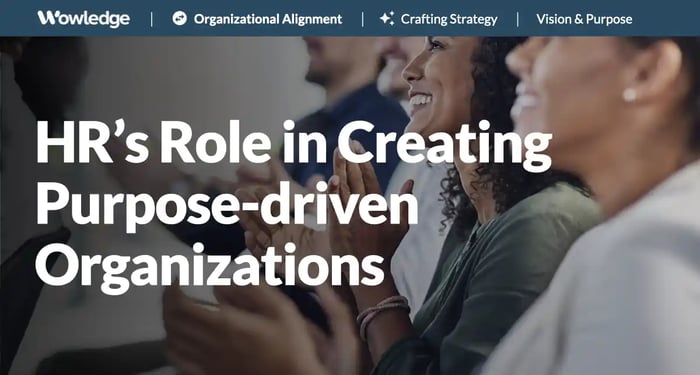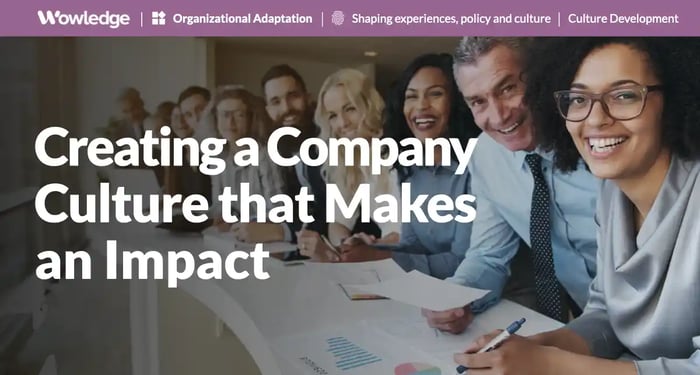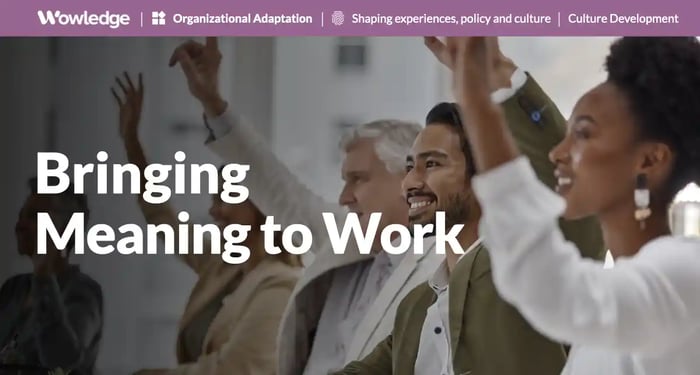Table of Contents
Corporate purpose is front and center in today’s business world. In recent years, CEOs and other business leaders have been increasingly vocal about defining their organizations' purpose as creating value for all stakeholders and not just maximizing profits. Much has been written about it, and it is considered an essential element of corporate visioning for the benefit of employees and stakeholders, and fundamental in a comprehensive HR Strategy. For example, Marc Benioff, CEO of Salesforce, said, "To be truly successful, companies need to have a corporate mission that is bigger than making a profit," and John Mackey, co-founder of Whole Foods, said, “Just as people cannot live without eating, so a business cannot live without profits. But most people don’t live to eat, and neither must businesses live to make profits.”
Of course, talk is cheap. What matters most is what leaders do to make purpose alive in their organizations. When defining and championing corporate purpose, HR leaders can have an essential part to play, given their focus on a key stakeholder group (i.e., employees). Still, too often, their role in defining and realizing corporate purpose needs to be articulated and/or clarified. What exactly is HR’s role in creating purpose-driven organizations?

HR’s role in purpose-driven companies
Purpose refers to a concrete goal or objective for an organization that reaches beyond profit maximization. HR has at least two critical roles in facilitating the pursuit of corporate purpose in the organization: understanding and promoting purpose from the ground up, and aligning the organization with its purpose. This post addresses these roles before also providing some caution regarding the limits to HR’s role in fostering purpose.
1. Understanding and promoting purpose from the ground up
Purpose lives in the hearts and minds of the organization’s stakeholders. Leaders can talk about purpose, but it is unlikely to succeed unless employees and other stakeholders have bought into their vision. HR should be proactive in helping business leaders understand how employees perceive the organization’s purpose and promote that purpose to employees in an impactful, genuine way. At the same time, insights and inspiration from employees can help shape how the organization defines its corporate purpose, and HR can help gather and synthesize employee input.
A good place for HR to start is by helping leaders gauge how employees view the organization’s purpose and the meaning that employees derive from being part of the organization. This goes beyond collecting a net promoter score or conducting a periodic engagement survey. It involves understanding how individuals perceive the “why” of the organization and how they do or do not identify with it and derive meaning from it. Expanded employee surveys addressing purpose and meaning are a helpful place to start but will likely not be enough to understand the purpose from employees' perspectives. HR should also empower leaders in the organization to listen to employees’ perspectives and concerns. Leader-employee one-on-ones, skip-level meetings, focus groups, employee advisory groups, and online collaboration tools are all potential ways for leaders to connect with employees to share their vision of the organization’s purpose and learn how employees perceive purpose. And HR can promote corporate purpose by encouraging the use of such employee listening devices and processes.
Ultimately, though, fostering purpose in the organization will be difficult unless leaders take a relational—rather than transactional—approach to managing the organization. This is because employees are unlikely to support a company’s purpose unless they feel they are trusted partners in pursuing a common purpose rather than merely pawns in pursuing profits for shareholders. An important lesson learned is that purpose cannot be imposed on an organization. It must be shared in the minds and hearts of the organization’s members to be meaningful. Leaders in the organization must take ownership of developing those relationships, but HR can facilitate this type of relationship-building and help remove roadblocks preventing leader-employee solid relationship-building.
2. Aligning the organization with its purpose
To truly embed purpose within a company's DNA, every aspect of the organization must align with its stated purpose. HR's responsibility is to ensure this consistency, from recruitment and onboarding to performance management and employee development. It means hiring individuals who resonate with the organization's purpose, fostering a purpose-driven culture, and designing policies reinforcing shared values. HR should also ensure that purpose is considered in performance measurement and incentives. Sometimes, purpose and profit are already fully aligned, leaving separate performance metrics and incentives unnecessary. In other cases, purpose and profit may diverge, and alternative metrics and incentives are needed to ensure that purpose is a focus in the organization. This could mean utilizing explicit performance metrics tied to a purpose beyond profit (e.g., reduced emissions as a target for a plant manager). In other cases, it could mean asking employees to comment on their contributions to the organization’s purpose in the performance review process.
Consistency is essential because any misalignment between purpose and practices can lead to skepticism and cynicism among employees. For example, suppose a manufacturing company promotes environmental sustainability as a critical part of its purpose but incentivizes its plant managers to maximize production output. Regardless of the environmental impact, its employees are more likely to view the company as profit-driven rather than purpose-driven. More importantly, a lack of consistency can derail an organization’s pursuit of purpose. Using the same example, a firm whose stated purpose is to be environmentally sustainable but whose plant managers are incentivized solely to maximize output is less likely to achieve its stated purpose. All aspects of the organization must work together to promote purpose and be mutually reinforcing.

The limits to HR’s role
While HR can and should be “purpose champions” in the ways described before, there are limits to what HR can do. The purpose must be envisioned and enacted by an organization’s leaders. HR can support and amplify the efforts of leaders to enact and promote purpose, but it cannot replace them. Efforts by HR to promote purpose that are not aligned with leaders’ efforts can backfire and come across as strategically misaligned, ingenuine, and ineffective. For example, HR leaders in an organization may see a need for increased diversity, equity, and inclusion (DEI) efforts. Still, unless the leaders of that organization recognize DEI as essential and connected to the organization’s purpose, those efforts are unlikely to have a lasting impact. They may be seen as ingenuine by employees and other stakeholders. Of course, HR can play a role in advocating for change, but HR leaders should be cautious about pushing changes that are ingenuine or disconnected from their organizations’ true purpose. When aligned with organizational leaders, they become effective facilitators in driving corporate purpose.
HR can play an essential role in fostering purpose within organizations. By understanding and promoting purpose from the ground up and aligning the organization with its purpose, HR can help ensure that purpose becomes more than just lofty statements spoken by CEOs periodically. HR can help purpose indeed “come alive” in the organization. While HR leaders should be careful to follow organizational leaders in pursuing purpose, they can also play an essential role in advocating for change and promoting a shared sense of purpose amongst an organization’s employees and other stakeholders.
Relevant Practices & Tools
Core HR Strategy Practices to Define a Foundational Direction for the HR Function. >
An HR Strategy defines the process of identifying business-based human resource (HR) tactics that will constitute a comprehensive multi-year approach to the management of the HR function... more »
Creating an Employee Experience that Bonds High Performers to the Organization. >
The employee experience constitutes the entire journey an employee takes with the organization. This includes everything from pre-hire to post-exit interactions and everything in between... more »
Fostering a Culture that Embraces Change Through Active Employee Engagement and Reinforcing Organizational Mechanisms. >
The existing organizational environment is perfectly designed to produce the current behaviors and outcomes, regardless of whether those outcomes are the desired ones... more »
Cascading and Updating Strategic Goals that are Aligned with Organizational Objectives. >
Creating a formal flow of goals from top executives down to the lowest level employees ensures an alignment of work efforts and objectives from the top to the bottom of the organization... more »
The Internal Environmental Scan Tool: Capture and Categorize Factors Internal to the Company Impacting its Objectives. >
This template provides a structure for identifying key internal topics that should be considered in a formal analysis of the business’s upcoming challenges... more »
FAQs
How can HR determine whether corporate purpose is genuinely internalized by employees?
HR can triangulate several signals, including purpose-specific survey item responses, qualitative themes from focus groups, and behavioral indicators such as volunteering for purpose-aligned initiatives or referrals motivated by mission. Tracking whether employees can articulate the purpose (and how their role contributes to it) in their own words during onboarding and performance check-ins is a practical litmus test. Upticks in retention for mission-critical roles and improved engagement in teams with purpose-linked goals provide corroborating evidence. Combining these inputs into a recurring “purpose adoption index” allows leaders to see progress over time.
What is the most effective way to link incentives to purpose without undermining financial performance?
Acting in alignment with the organization’s purpose is inherently motivating for employees who understand how their work contributes to the broader mission. As a result, financial incentives are less effective. However, a balanced scorecard that blends financial, customer, operational, and purpose metrics keeps trade-offs explicit. HR can weight purpose outcomes at a meaningful but not dominant percentage of variable pay, with thresholds to avoid rewarding (apparent) mission-related actions without results. Where purpose and profit diverge, guardrails and negative screens prevent goal gaming while preserving line-of-sight for managers. Regular project, initiative, and quarterly or annual post-mortems ensure payouts reflect verifiable impact rather than activity counts.
What can HR do when leadership actions contradict the stated purpose?
HR should document the misalignment with evidence tied to policies, metrics, and employee feedback, then present concrete options that realign behavioral expectations, incentives, and operating practices. If the gap stems from unclear priorities, a decision forum can reset the order of precedence among outcomes when purpose and profit collide. Communication should acknowledge the discrepancy and publish time-bound corrective steps to retain credibility. Persistent conflicts require governance escalation through the board or a designated ethics committee.
How can HR embed purpose into performance management without adding bureaucracy?
Managers can communicate how the job contributes to the company's mission and values during recruiting and onboarding sessions. They should translate the corporate purpose into two or three role-specific outcomes and behaviors to be reviewed in regular check-ins, not just annual cycles. OKRs or goal frameworks can include one purpose-linked objective with measurable key results, keeping the conversation outcome-focused. Talent performance calibration sessions should examine the consistency of purpose ratings across teams to reduce halo effects. Lightweight narrative prompts in reviews help capture qualitative impact that metrics may miss.










